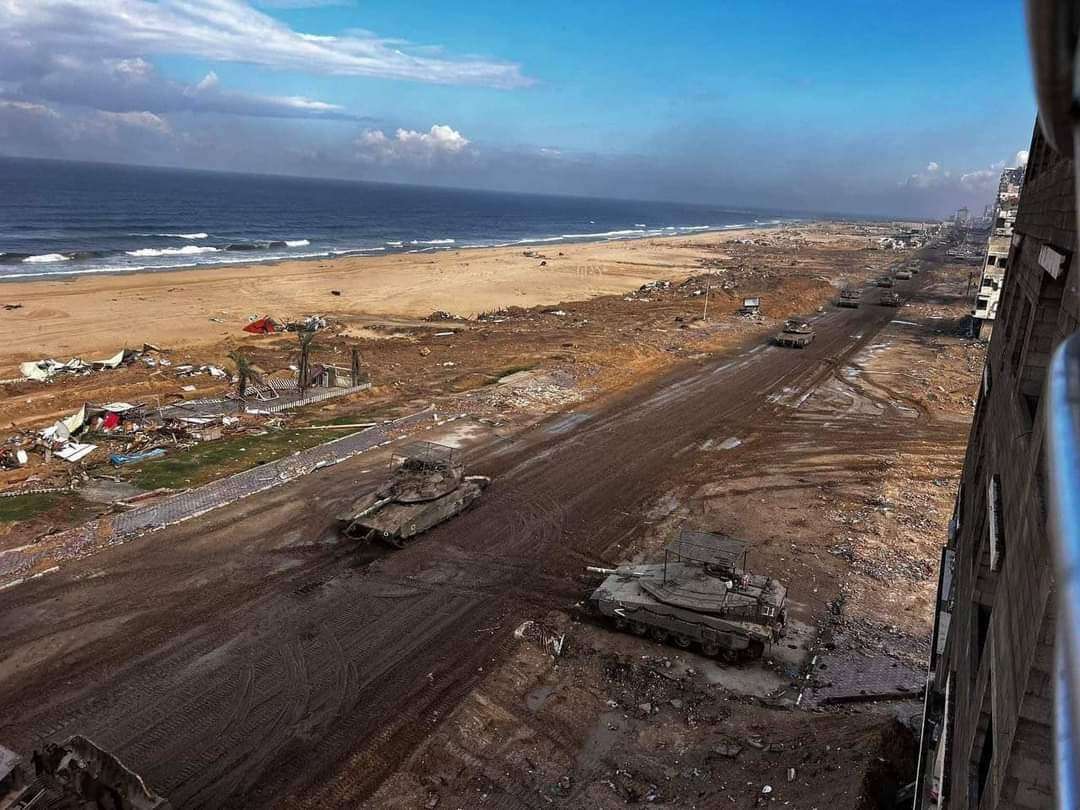Isolating Gaza Palestinian Territory – The Israeli army’s control of the Netzarim Corridor and Al-Rashid Street, which prevents civilians from returning to Gaza City, constitutes a dangerous step towards fragmenting the territorial integrity of the Gaza Strip by isolating Gaza City and the northern areas and turning them into besieged zones. This creates coercive conditions that make civilian survival impossible and effectively result in their forced displacement.
Israel is seeking to displace the remaining population of Gaza City by denying them food, medicine, and fuel, cutting off humanitarian aid, and intensifying its policy of systematic starvation as part of its ongoing genocide against Palestinians in Gaza.
Euro-Med Monitor expressed deep concern over the announcement by Israeli army spokesperson Avichay Adraee that Al-Rashid Street would be closed to movement from the southern Gaza Strip as of 12:00 noon today. Consequently, movement from the central Gaza Strip to Gaza City will be prohibited, while, for now, those who have not yet evacuated the city will be permitted to move south without inspection.
This suggests that the Israeli army is preparing to intensify the isolation and eventually enforce a complete closure, imposing arbitrary restrictions on residents, diverting movement to a one-way route southward, and preventing return, in an effort to impose a new demographic reality by depopulating Gaza City.
Adraee’s announcement was followed by a statement from Israeli Defence Minister Yisrael Katz, who said that the army was finalising its control of the Netzarim Corridor extending to the seashore to isolate Gaza City. He described this as the “last chance” for Gaza residents to move south, warning that anyone remaining in the city would be deemed a combatant or a supporter of terrorism.
This statement constitutes a direct threat to defenceless civilians and exposes an explicit policy of forced displacement, starvation, and collective punishment, in blatant violation of international humanitarian law, particularly the principles of distinction and the presumption of civilian status in cases of doubt.
These statements clearly reveal the Israeli army’s intention to re-establish its presence in the area, turning it into a battleground for killing, abuse, arrests, and enforced disappearances of Palestinians, as occurred prior to the 19 January ceasefire agreement, which Israel unilaterally violated before its full implementation could be completed in March.
As an occupying power, Israel’s partition of the Palestinian territories violates the Palestinian people’s right to self-determination. Under customary international law, territorial integrity and contiguity are inherent and indispensable components of this right, which constitutes a peremptory norm of international law allowing no exceptions whatsoever.
The division of land is often followed by the seizure of all or parts of that territory, an act absolutely prohibited under international law as a peremptory norm. It forbids the use of force to seize the lands of other peoples or states under any security pretext advanced by Israel. In its advisory opinion issued last July on the legality of Israel’s occupation of the Palestinian territories occupied since 1967, including the Gaza Strip, the International Court of Justice affirmed that Israel has no sovereignty over these territories and that security considerations cannot justify violating the principle prohibiting the acquisition of territory by force.
Preventing Palestinians from returning to Gaza City has catastrophic consequences, as it entrenches a systematic policy of siege and starvation affecting more than 300,000 people still trapped in the city. It completely cuts them off from food and medical supplies that previously arrived from the south after Israel halted aid entry through the newly established Zikim crossing in the north. This places the population at imminent risk of famine and total health collapse, exposing the use of siege and starvation as instruments of war and genocide against the civilian population.
This dangerous decision deepens civilian suffering by separating families and preventing communication between them. Many families have been forced to split, with some relocating to the central or southern Gaza Strip while others remain in Gaza City. Their members had previously moved between the two areas to preserve family ties, but this decision has forcibly severed those connections.
Furthermore, the decision eradicates the limited economic activity that had survived under siege and aggression, depriving hundreds of families of their only sources of income. It further entrenches the policy of starvation and reduces civilian life in the city to a state of complete deprivation of the basic necessities of survival.
The closure of the Netzarim Corridor and Al-Rashid Street effectively strangles the few partially functioning hospitals in Gaza City, cutting them off from essential medical supplies and staff. This comes at a time when 20 hospitals are completely out of service and the number of casualties, both dead and wounded, continues to rise daily, leaving no capacity for response or rescue.
Immediate international action is required. The UN General Assembly must convene an emergency special session under its historic Resolution 377 A(V) “Uniting for Peace,” which empowers it to act when the Security Council fails to do so due to vetoes or lack of consensus. The Assembly should adopt a resolution to form and deploy a peacekeeping force in Gaza to halt crimes against civilians, guarantee unhindered humanitarian aid, protect health and relief facilities, end the blockade, and facilitate reconstruction.
All states, individually and collectively, must urgently act to stop the genocide in Gaza, fulfil their legal obligations to protect Palestinian civilians, and ensure Israel’s compliance with international law and the binding rulings of the International Court of Justice.

